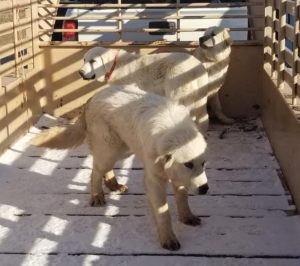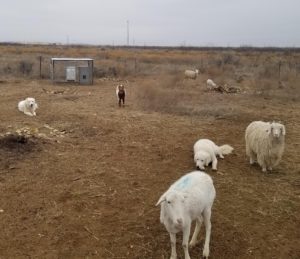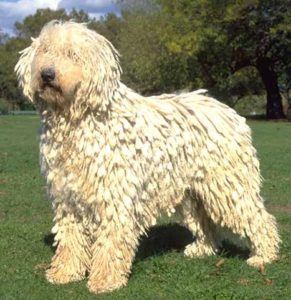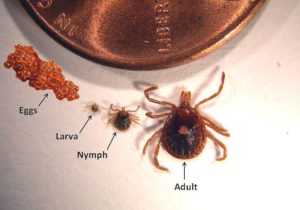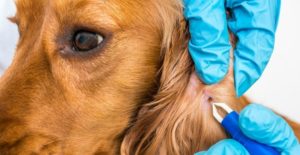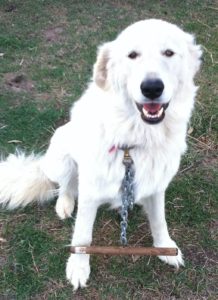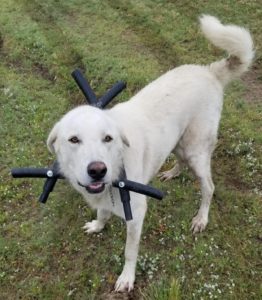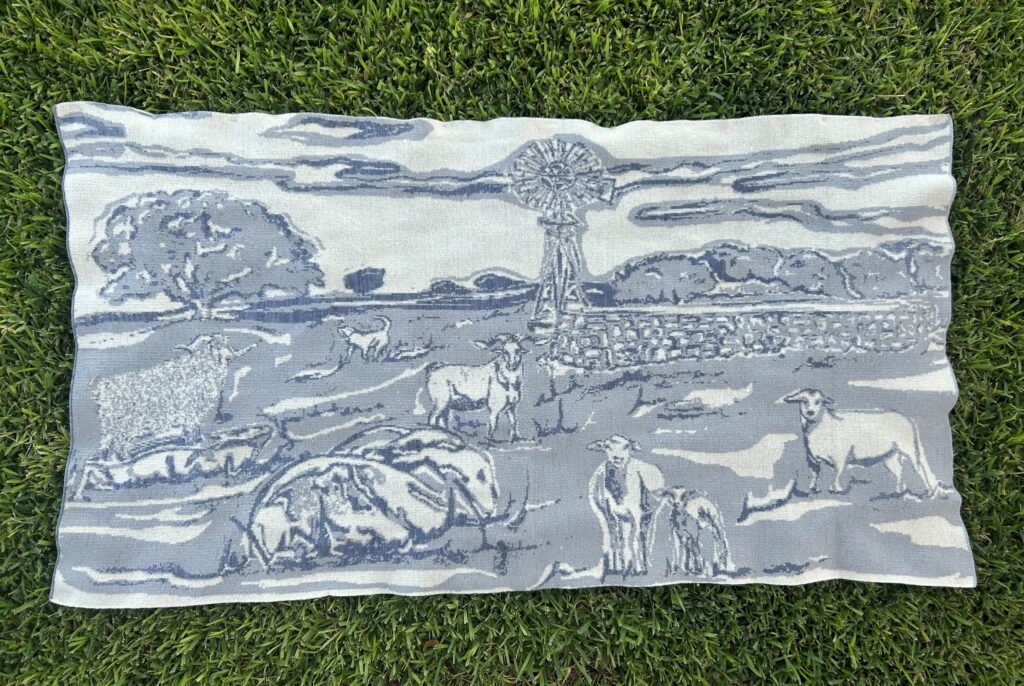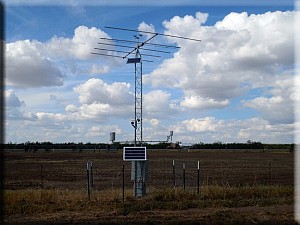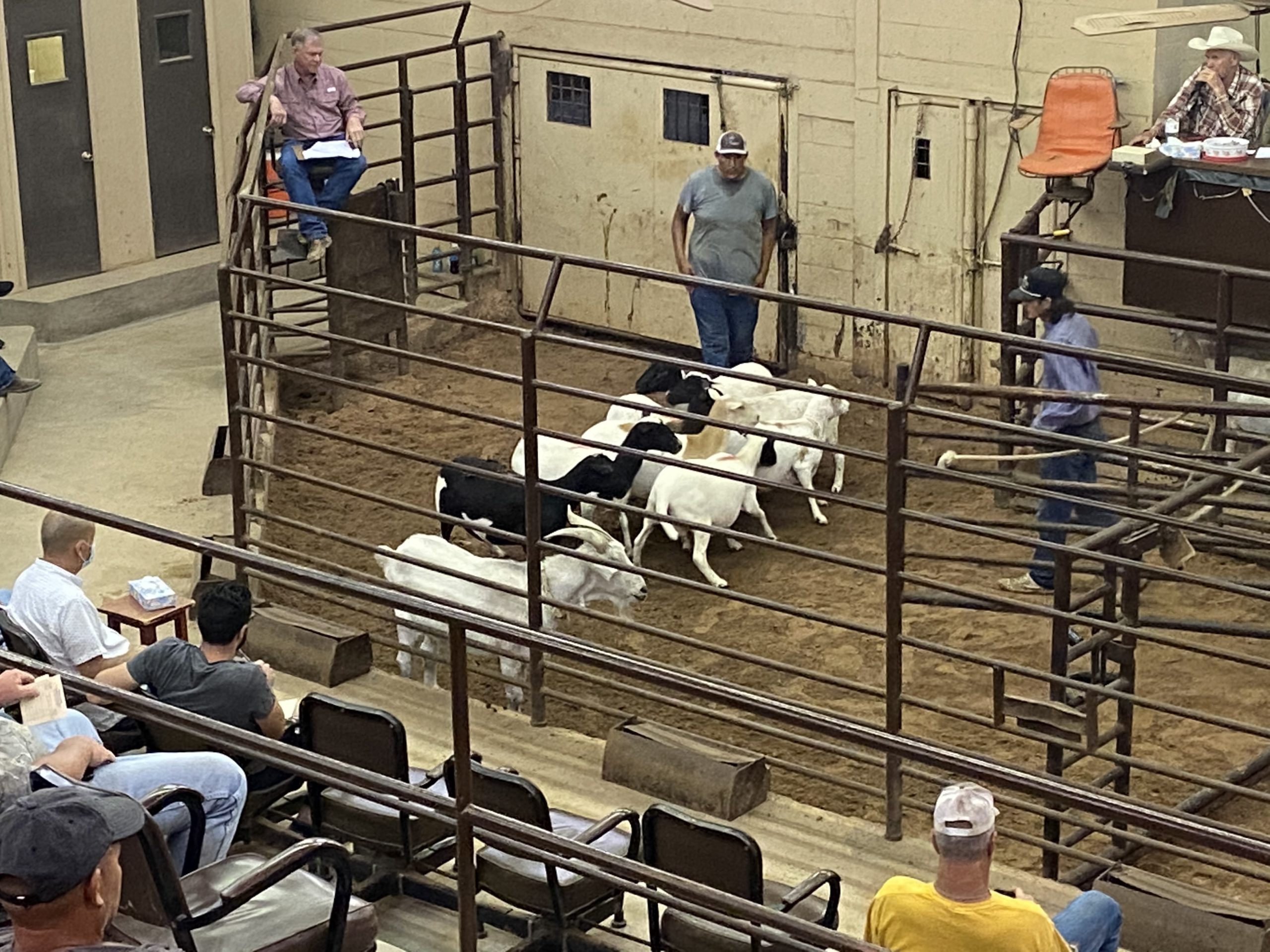Proper Diets for LGDs
Don’t be penny wise and a pound foolish when it comes to feeding your LGD! Proper nutrition for you LGDs is extremely important if you want them to consistently perform at their optimum level while protecting your herd. We recommend that you feed your LGD a high-quality dog food with animal protein as the first ingredient with a high protein and fat content. This type of kibble will provide your LGD a balanced diet to meet their daily requirements throughout the year.
According to Dr. Chelsy McGivney DVM, for Nestle Purina Pet Care, working dogs have unique nutritional needs compared to the average companion animal. “The increased activity due to the nature of their jobs expends a lot of energy, and these calories must be replaced through their diet. Offering working livestock guardian dogs, a diet high in protein and fat ensures that we are meeting these dogs’ energy needs, while at the same time offering an optimal amount of protein to ensure maintenance of lean muscle mass. Optimal nutrition allows these working dogs to endure longer stretches of activity to be able to keep their livestock charges safe.”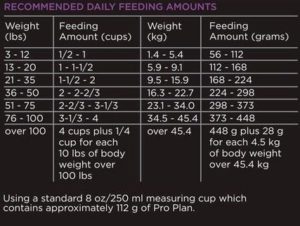
Dog food is measured in cups which are 8 ounces. Dog food bags should have a chart on them with the daily recommended amount of kibble to be fed. It’s important that you check, not only the ingredients, but the caloric content of the feed. Bags of feed may have the same ingredients and protein/fat contents, but how its processed makes the difference in whether all the nutrients are available to be digested by the dog. Based on daily caloric requirements, the Merck Veterinary Manual recommends that a 100-pound neutered working dog needs about 2,000 calories per day. This equates to about 5 cups of feed per day. This follows my own experience that the average LGD needs at least 5-6 cups (2 ½ – 3 pounds) of feed per day to maintain their current body condition. If your dog is more active, such as during lambing/kidding season, or trying to stay warm during winter weather their metabolism will increase which will require more calories to be consumed. If you are using a self-feeder, its extremely important to estimate the amount of feed intake your dog will need before you return to refill the feeder. It’s a good idea to place a game camera on your dogs feeder so that you can track how often the dog is eating, along with the amount lost to varmints. You don’t want your dog running out of feed at a critical time during the year.
On most extensively managed ranches, it is not possible to keep LGD from consuming placentas and dead lambs or kids. Consumption of these items is considered a positive benefit by many ranchers because it removes these food items that attract other predators and carrion feeders. Nonetheless, do not make you LGD solely rely on these other sources of food. You must ensure that they have reliable access to a source of food provided by you in the form of dry kibble. If your LGDs have to find their own food supply, it leads to wandering dogs that aren’t guarding their livestock and often results in problematic behavior along with a poor body condition of your LGD.
It’s important to check you dogs body condition score, or BCS, on a regular basis. There is a great canine body condition score sheet at https://www.proplanveterinarydiets.ca/wp-content/uploads/2016/05/Body-Condition-System-Poster-2016-EN-FINAL.pdf that you can download and use to monitor your dog’s score. Ideally you want your LGD to always be a 5 BCS. Once it dips t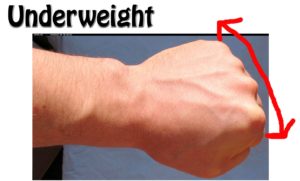 o a 4 or lower you will need to increase the feed intake and provide supplemental protein sources to return you dog to a health body condition.
o a 4 or lower you will need to increase the feed intake and provide supplemental protein sources to return you dog to a health body condition. 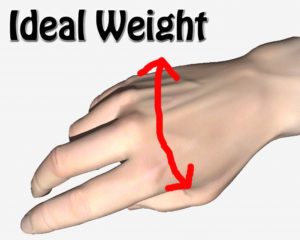
Checking your dog’s body condition is done by feeling its ribs and down its spine. If those areas feel like the area on top of your knuckles with your hand facing palm down, then your dog should be a 4-5 body condition score. If the dog’s ribs feel like your knuckles when you close your hand to make a fist, then your dog is under condition and needs more feed.
Sources: https://www.successjustclicks.com/fit-fido-or-fat-fido/ and https://www.merckvetmanual.com/management-and-nutrition/nutrition-small-animals/nutritional-requirements-and-related-diseases-of-small-animals?query=canine%20nutrient%20requirements
LGD Puppy Bonding Project
All the pups have left the AgriLife Center in San Angelo and are out protecting herds of livestock. The Superheroes went to one of our research ranches near Ozona and they are “learning the ropes” guarding our Rambouillet sheep with one of our best LGDs, Duchess. Duchess is a 4-year-old female Akbash cross that never roams and does a great job protecting our herd. They are still being monitored once or twice a week at the ranch. The dogs are a welcome addition to that ranch as we have been down a couple of guardian dogs at that location due to health issues. Two of our dogs at that ranch had Ehrlichiosis and were brought back to the AgriLife Center in San Angelo for several weeks to medicate them daily with doxycycline. After finishing their medication, they headed back out with the Superheroes to get back to work.
The Stooges left the AgriLife Center in mid-February for a cooperating ranch to guard Dorper ewes and lambs. The producer has never used LGDs on his operation and is excited to see if they can help control predation. The pups were bonded to 15 of the producer’s sheep at the AgriLife Center for two weeks before being transported to his ranch. Once at the ranch, the dogs were introduced to the entire herd in a small trap for a couple days before being released into a large pasture. The producer will check on the dogs several times a week and provide regular feedback to us on their progress. We will be providing advice to the producer on the dogs for the duration of the project, as well as making periodic visits to check on the dogs.
Breed Spotlight – Komondor
Komondor are descended from Tibetan dogs, that were brought to Hungary by nomadic Magyars, and the Aftscharka dog, which the Hungarians found on southern steppes in Russia. They are confident and tough enough to run off wolves and other predators. The dreadlocks give the dog a cool look, but they aren’t for show. They provide protection from extreme cold weather and sharp-toothed predators. Their coat requires considerable care which is why most owners of working Komondors keep their cords clipped to about 4 to 6 inches in length. There muzzles feet and ear canals must be clipped short on a regular basis to avoid health conditions. The cords also let the dogs blend in with the sheep, giving them the element of surprise.
The Komondor is a large, muscular dog with plenty of bone and substance. Komondors tend to be aggressive to other dogs and strangers that are not members of its flock. They tend not to wander from their stock but can be excellent fence climbers.
Based on a 1982 study published in the Journal of Range Management using nine Komondors, the researchers found that the dogs tended to observe their area rather than patrol it. They also found that they are extremely territorial and react quickly to any perceived threat. Some of the dogs became more aggressive towards threats over the length of the trial. The Komondors used in the trial also had a low inclination to chase sheep, but the researchers recommended that early socialization with several different humans and different sheep would minimize behavioral problems in adult dogs. The researchers also reported that: “In 79 of the 153 coyote-sheep interactions which we observed, the sheep either stayed with or ran to the dog and, in 75 of the 79, the dogs stood between the sheep and the coyote or chased the coyote away. The dog ran to the sheep and repelled the coyote in five additional instances. Sheep were never attacked while with a dog.”
Height for male dogs ranges from 27½ – 31½ inches and 25½ – 27½ inches for females. Weight for males ranges from approximately 100 to 130 pounds and females range from 88 to 110 pounds. The skin around the eyes and on the muzzle is a dark gray to protect them from the sun. The Komondors coat color is white to ivory. A small amount of cream or buff shading is sometimes seen in puppies, but fades with maturity. The long, dense ivory hair coat is double layered, with a coarse outer coat and finer undercoat. The coat naturally tends to cord or matt as the dog ages since this dog does not shed its coat. Length of coat corresponds to age and the puppy coat is relatively soft, but it shows a tendency to fall into cord-like curls at about 6-8 months of age. A grown dog is entirely covered with a heavy coat of these tassel-like cords, which form naturally. This dog breed would not be recommended for use in wet or very warm climates such as, West and East Texas, due to its long, thick hair coat length unless the producer plans to shear them regularly. Due to their thick coat, a wet dog can take 2-3 days to fully dry out which can cause hot spots, skin infections and mildew can occur in wetter climates. Areas with high flea and tick populations can cause bare spots in the coat from the dog scratching out the cords.
Sources:
https://www.akc.org/dog-breeds/komondor/
https://www.ukcdogs.com/komondor
https://komondorclubofamerica.org/about-the-komondor/
McGrew, Blakesley, “How Komondor Dogs Reduce Sheep Losses to Coyotes”, Journal of Range Management, 1982, November (Pages 693-696)
External Parasites – Ticks
This is the first part of a three-part series on external parasites. It’s advised to treat your LGDs for external parasites year-round. Not only are fleas and ticks a nuisance to LGDs, they can spread diseases between host animals and humans. Ticks commonly transmit disease agents such as viruses, bacteria and protozoa.
Ticks are usually between 1/8”- 3/16” long and attach securely to their hosts. They can also spread both additional ticks and microorganisms to different geographical habitats via traveling animals. There are two types of ticks to be concerned with in the U.S., soft ticks and hard ticks. Soft ticks have a leathery appearance, use a nest and feed for shorter periods before they drop off the animal. Hard ticks have a hard-ornate outer shell and feed for longer periods than soft ticks. The most important species of hard ticks in North America as parasites of LGDs are the Black-legged Deer tick, American Dog tick, Brown Dog tick and the Lone Star tick.
Ticks are blood feeders and most active stages require blood as a nutritive source. All ticks have four stages of development, the egg and the three active stages: the larva, the nymph and the adult. Due to the mechanical processes and salivary secretions associated with blood feeding, the tick-host parasitic interaction is complex. Salivary secretions from the ticks contain a variety of substances that work against the animal’s natural immune system and allows the tick to continue feeding on its host until its fully engorged. In most species, each active stage seeks a host, feeds, and drops off to develop in the natural environment (three-host life cycle). A contact between ticks and hosts is regulated by at least five conditions. They consist of seasonal and daily effects like day length, temperature, humidity, biological processes within the tick, the biological processes within the host and interactions between the two organisms.
Ticks can spread a variety of diseases such as Anaplasmosis, Babesiosis, Ehrlichiosis, Lyme Borreliosis (Lyme Disease), Rickettsioses (Rocky Mountain Spotted Fever), Hepatozoonosis, Hemoplasmas, Tick-Borne Encephalitis and Tick Paralysis. A mentioned in the January issue of the Guardian Way, two of our LGDs recently were diagnosed with Ehrlichiosis and had to be treated twice a day with Doxycycline for three weeks. Since these dogs were diagnosed at different stages of the disease their condition was drastically different. Ehrlichiosis can be fatal, but luckily, we caught it in time with both dogs. Our male LGD, Max, had been infected for quite some time. He was extremely thin, weak and had severe diarrhea. Duchess our female, was diagnosed at the early stages of the disease and was still in good condition. Both dogs have recovered and are back out guarding livestock. According to our veterinarian Ehrlichiosis is very prevalent south of Interstate 10 and can be found in pockets north to Highway 87. A simple blood test can be used to see if your dog is infected. For more information about tick borne diseases check out this website http://www.cvbd.org/en/tick-borne-diseases/. Prevention and quick removal of ticks will help minimize the transmission of these diseases to you LGDs.
The recommended method to remove attached ticks from your LGDs is to use fine-tipped tweezers, special tick tweezers or shield your fingers with a paper towel or rubber gloves to protect yourself. Grasp the tick as close to the dog’s skin surface as possible and pull upward with steady, even pressure. Do not twist or jerk the tick; this may cause the mouth parts to break off and remain in the skin. If this happens, remove the mouth parts with tweezers. Do not squeeze, crush, or puncture the body of the tick because its fluids (saliva, body fluids, gut contents) may contain infectious organisms. After removing the tick, thoroughly disinfect the bite site and wash your hands with soap and water.
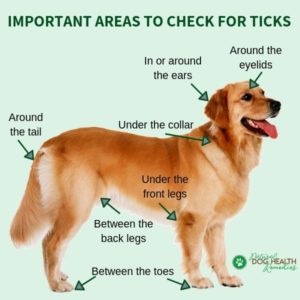 As with most things, prevention is the best method when dealing with ticks. There are several different types of parasiticides available on the market to control ticks on your LGDs. We do not recommend that you use cattle, sheep or goat parasiticide products on your LGD without talking to your veterinarian. Some livestock products can be deadly to your LGDs. Depending on your situation you may want to use a chewable tablet, collar, spray, dust, shampoo or a spot-on treatment. We use a long acting chewable tablet on all the dogs at the AgriLife Center that controls fleas and ticks. If you are using a topical product look for one with a with an IGR (insect growth regulator). An IGR helps ensure that all phases of a parasite’s life cycle will be affected by the active ingredient in the parasiticide you use. Again, its best to consult your veterinarian for a product they recommend for you specific area.
As with most things, prevention is the best method when dealing with ticks. There are several different types of parasiticides available on the market to control ticks on your LGDs. We do not recommend that you use cattle, sheep or goat parasiticide products on your LGD without talking to your veterinarian. Some livestock products can be deadly to your LGDs. Depending on your situation you may want to use a chewable tablet, collar, spray, dust, shampoo or a spot-on treatment. We use a long acting chewable tablet on all the dogs at the AgriLife Center that controls fleas and ticks. If you are using a topical product look for one with a with an IGR (insect growth regulator). An IGR helps ensure that all phases of a parasite’s life cycle will be affected by the active ingredient in the parasiticide you use. Again, its best to consult your veterinarian for a product they recommend for you specific area.
Source:
https://www.cvbd.org/en/tick-borne-diseases/about-ticks/
https://www.natural-dog-health-remedies.com/dog-ticks.html
Breeder Profile
This month’s LGD breeder and rancher that is effectively using LGDs in their operation is Dayn Pullen of the Noelke Wilhelm Ranch in Menard, Texas.
Q: Describe your operation/ranch.
- How many LGDs do you currently use?
- Explain your LGD program.
A: We run DNA verified Spanish goats, along with registered savannas. We have a total of 450 head, as of now. We also run cattle on the ranch. We move and rotate all the stock when necessary and utilize planted fields when we get the rain. We have about 1,800 acres total and use eight guard dogs. We use this many due to the amount of brush and rough terrain we have. We use six to nine working dogs on the Noelke Wilhelm Ranch NWR at any given time. We also have six breeding dogs, that are older retired dogs we have used on our ranch. We continue to use each of these on the ranch when needed. The litters we raise are put with goats at 8 weeks of age, and work until 6 months of age. We give all three puppy shots, and a rabies shot, before we sell them at 6 months old. We wait this long to sell because it assures the dogs are big enough physically, and mature enough mentally, to do the job they will be asked to do.
Q: What got you started in breeding LGDs?
A: We started using LGDs to stay in the goat business. We are surrounded by coyotes and hogs, so LGD protection is the only thing keeping our goat operation alive, literally. As far as breeding them goes, we bred the dogs we had, for our own replacements. I needed something to do with the excess dogs, so we started selling them to people we knew.
Q: How long have you bred LGDs?
A: I have been breeding LGDs for 6 years.
Q: What breed of LGDs do you raise?
A: We raise and use pure Great Pyrenees, pure Anatolian Shepherd, and we cross them for some 50%ers. We are considering retiring the Anatolian Shepard pair as they are getting old. We may start raising pure Akbash and crossing them with the Great Pyrenees as well.
Q: Do you have an LGD mentor?
A: No. I just knew we had to have LGDs to stay in business. I called Connie Dittmar and was able to purchase four female, and two male Great Pyrenees dogs. I prayed hard about how and what to do with them. When I felt like I had the right approach in mind, I went with that.
Q: What’s the one thing you wish you knew before starting to breed LGDs?
A: Nothing honestly. The whole process has been a blessing. Not just for our livestock, and their success, but for the chance to spread the word about LGDs. Being able to supply good dogs to ranchers that are in the same position we were in when we bought our first dogs, is a good feeling.
Q: What is the number one thing you recommend to a new LGD user?
A: There are two things that I feel are the most important. First, people who buy LGDs, need to seek out a reputable breeder, that has proven dogs. After that, ACCLIMATION! Acclimating the right way, and for the proper amount of time is essential. Getting the dogs AND the livestock they are going to guard, to securely bond is vital to the success of the dogs, and your operation.
LGD Timely Tips
Every Tuesday check out our Facebook page @TAMUlivestockguardog for Tuesday’s LGD Tip of the Week!
- A dangle stick is a good deterrent for an LGD puppy that chases stock when you aren’t around. Make sure to use a swivel at each end so the device does not get tangled up.
- An inexpensive air horn works well to discourage misbehavior from pups if you can catch them in the act. Always correct any misbehavior in your LGD immediately.
- A yoke is a good way to deter an LGD from digging under fences if you don’t have hot wire. PVC pipe or rigid tubing works well. Just make sure it’s not too heavy and they can still eat and lay down!
To provide feedback on this article or request topics for future articles, please contact me at bill.costanzo@ag.tamu.edu or 325-657-7311.
Bill Costanzo
Research Specialist II, Livestock Guardian Dogs
Follow us on Facebook: https://www.facebook.com/TAMUlivestockguarddog/

